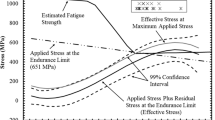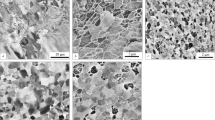Abstract
Cracking in continuously cast steel slabs has been one of the main problems in casting for decades. In recent years, the use of computational models has led to a significant improvement in caster performance and product quality. However, these models require accurate thermomechanical properties as input data, which are either unreliable or nonexistent for many alloys of commercial interest. A major reason for this lack of reliable data is that high-temperature mechanical properties are difficult to measure. Several methods have been developed to assess the material strength during solidification, especially for light alloys. The tensile strength during solidification of a low carbon aluminum-killed (LCAK; obtained from Tata Steel Mainland Europe cast at the DSP plant in IJmuiden, the Netherlands) has been studied by a technique for high-temperature tensile testing, which was developed at Sumitomo Metal Industries in Japan. The experimental technique enables a sample to melt and solidify without a crucible, making possible the accurate measurement of load over a small solidification temperature range. In the current study, the tensile test results are analyzed and the characteristic zero-ductility and zero-strength temperatures are determined for this particular LCAK steel grade. The fracture surfaces are investigated following tensile testing, which provides an invaluable insight into the fracture mechanism and a better understanding with respect to the behavior of the steel during solidification. The role of minor alloying elements, like sulfur, in hot cracking susceptibility is also discussed.











Similar content being viewed by others
References
K.O. Yu: Modelling for Casting and Solidification Processing, 1st ed., Marcel Dekker, New York, NY, 2009.
C. Monroe and C. Beckermann: Mater. Sci. Eng. A, 2005, vols. 413-414, pp. 30–36.
D. Eskin, Suyitno, and L. Katgerman: Progr. Mater. Sci., 2004, vol. 49, pp. 629–711.
K. Hansson: Ph.D. Dissertation, Royal Institute of Technology KTH, Stockholm, Sweden, 2001.
J.A. Dantzig and M. Rappaz: Solidification, 1st ed., CRC Press, Lausanne, Switzerland, 2009, pp. 429–72, 519–63.
Y.M. Won, T.J. Yeo, D.J. Seol, and K.H. Oh: Metall. Mater. Trans. B, 2000, vol. 4B, 31, pp. 779–94.
D. Eskin and L. Katgerman: Metall. Mater. Trans. A, 2007, vol. 38A, no. 7, pp. 1511–19.
K. Fisher and W. Kurz: Fundamentals of Solidification, 4th ed., Trans Tech Publications, Ueticon-Zuerich, Switzerland, 1998, pp. 63–92, 117–32.
A. Chojecki, I. Telejko, and T. Bogacz: Theor. Appl. Fract. Mech., 1997, vol. 27, pp. 99–105.
T. Nakagawa, T. Umeda, J. Murata, Y. Kamimura, and N. Niwa: ISIJ Int., 1995, vol. 6, no. 35, pp. 723–29.
R. Pierer, C. Bernhard, and C. Chimani: Rev. Metall., 2007, vol. 2, pp. 72–83.
H. Mizukami, S. Hiraki, M. Kawamoto, and T. Watanabe: Tetsu-to-Hagané, 1998, vol. 84, no. 11, pp. 763–68.
H. Mizukami, A. Yamanaka, and T. Watanabe: ISIJ Int., 2002, vol. 9, no. 42, pp. 964–73.
N. Baba, K. Ohta, Y. Itoh, and I. Kato: Rev. Metall., 2006, vol. 4, pp. 174–79.
T. Kato, M. Kawamoto, A. Yamanaka, and T. Watanabe: ISIJ Int., 2003, vol. 43, no. 11, pp. 1742–50.
B. Rogberg: Scand. J. Metall., 1983, vol. 12, pp. 51–66.
T. Emi and A.W. Cramb: Surface Defects on Continuously Cast Strands—Casting Volume, 11th ed., The AISE Steel Foundation, Pittsburgh, PA, 2003, pp. 4–6.
ASM Handbook, Volume 12: Fractography, 11th ed., ASM International, Materials Park, OH, 1987, pp. 99, 620–70, 1012.
G. Van der Voort: ASM Handbook, Volume 09: Metallography and Microstructures, 8th ed., ASM International, Materials Park, OH, 2004, pp. 220–21.
M.C. Flemings and L. Bigelow: Metall. Mater. Trans. B, 1975, vol. 6B, no. 2, pp. 275–83.
Acknowledgments
This research was carried out under project number M41.5.08320 within the framework of the Research Program of the Materials innovation institute M2i (www.m2i.nl). The authors would like to thank the contribution of Prof. Andrew Howe in the fractographic analysis and the discussion of the results of this study. The extensive SEM studies were performed together with MSc Sabri Sengo and Dr. Jean Campaniello from Tata Steel RD&T.
Author information
Authors and Affiliations
Corresponding author
Additional information
Manuscript submitted January 25, 2012.
Rights and permissions
About this article
Cite this article
Santillana, B., Boom, R., Eskin, D. et al. High-Temperature Mechanical Behavior and Fracture Analysis of a Low-Carbon Steel Related to Cracking. Metall Mater Trans A 43, 5048–5057 (2012). https://doi.org/10.1007/s11661-012-1331-1
Published:
Issue Date:
DOI: https://doi.org/10.1007/s11661-012-1331-1




